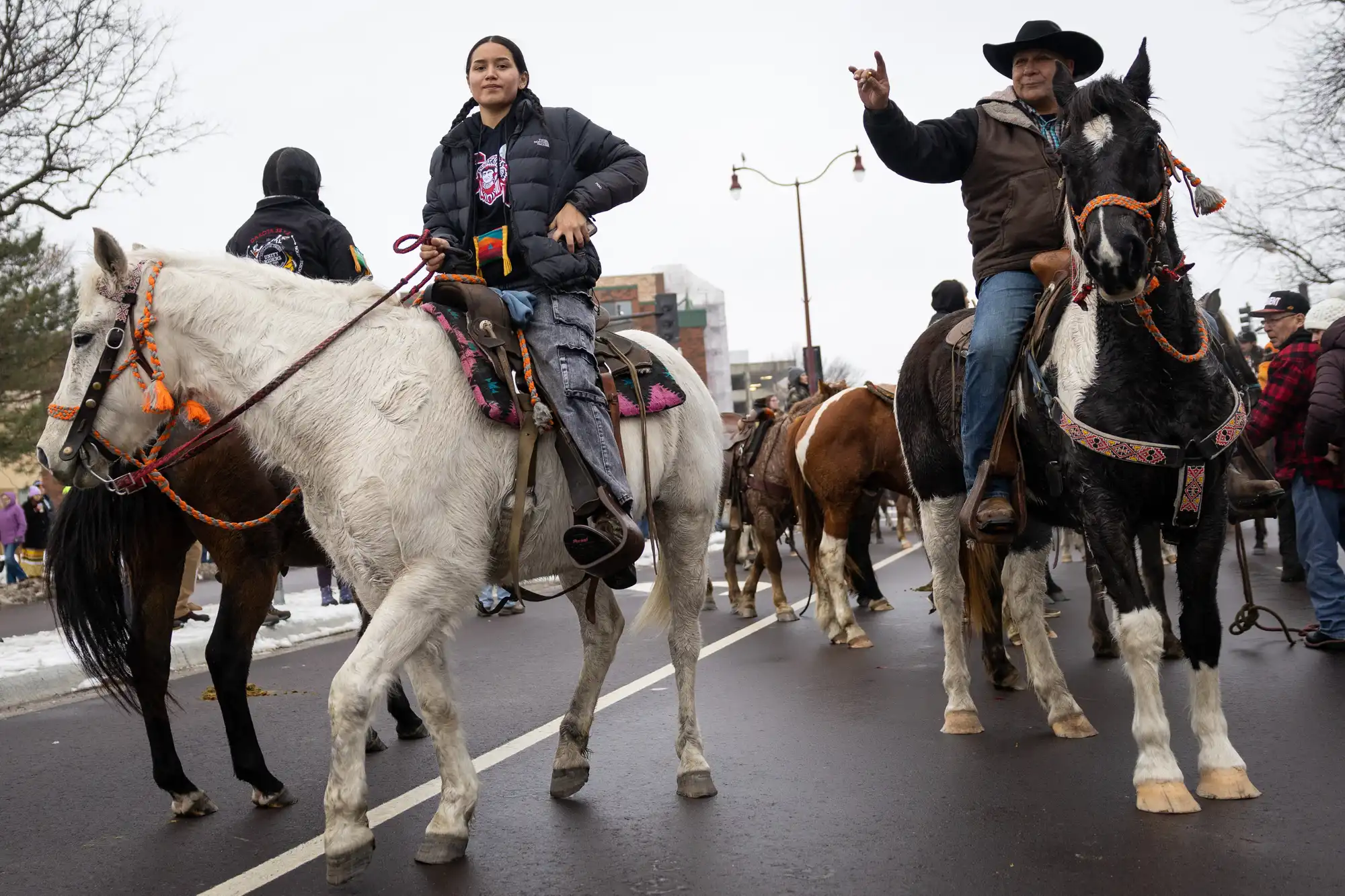
- Details
- By Kaili Berg
After a one-year hiatus, Dakota horse riders returned to Mankato, Minnesota, to honor the memory of the December 26, 1862, mass execution of Native Americans. Ordered by President Abraham Lincoln, this event remains the largest mass execution in U.S. history.
From 2008 to 2022, the Dakota 38+2 Memorial Ride was held annually to commemorate the lives lost following the U.S.-Dakota War of 1862.
The Memorial Ride concluded in 2022 after the passing of its founder, Jim Miller, a Dakota spiritual leader and Vietnam veteran, who succumbed to cancer in May 2023.
Miller envisioned the ride as a way to honor the 38+2, acknowledge the pain of the past, and work toward healing. His dream of reconciliation now lives on through the annual journey, drawing participants from across the Midwest and beyond. Riders include Dakota descendants, allies, and youth who are taking up the mantle to ensure this history is never forgotten.
This year, two new rides emerged — the Makatoh Reconciliation and Healing Horse Ride from Lower Brule, S.D., led by Wilfred Keeble, and the Dakota Exiles ride from Santee, Neb., led by Jim Hallum.
Two new rides, called the Makatoh Reconciliation and Healing Horse Ride, were launched this year.
Wilfred Keeble, a participant in the original ride, shared that Miller encouraged him to carry it forward with the next generation.
"We ended 38+2, but he said the ride needs to go on for the coming generations," said Keeble, "We have a young group with us, they’re excited. They want to continue on."
The Dakota riders retrace a painful chapter in history, riding horseback across the Midwest to honor their ancestors and the 38 men executed in 1862.
The ride begins in Lower Brule, South Dakota, and spans nearly 330 miles, culminating at the execution site in Mankato. Over the course of two weeks, riders will brave freezing winter conditions on horseback, stopping in communities along the way to hold ceremonies, share history, and foster dialogue.
The physical journey is grueling, with riders spending hours in the saddle during bitterly cold days. Each stop along the route carries significance, offering moments of reflection and community connection.
Riders often stay in churches, community centers, or schools where they host educational events and ceremonies, sharing the story of the Dakota 38+2 and inviting dialogue about history and its impact today.
The long horse ride also serves as a reminder of the struggles the Dakota people endured during and after the war. The events of 1862 included forced removal, mass incarceration, and the loss of land and lives, traumas that still resonate today.
While it’s rooted in pain, the ride is also about hope and healing. By retracing the steps of their ancestors, the riders are not only honoring the past but also working toward understanding and reconciliation. For those who witness or participate in the journey, it’s a powerful reminder of the importance of keeping history alive.
More Stories Like This
Native News Weekly (August 25, 2024): D.C. BriefsUS Presidents in Their Own Words Concerning American Indians
Indigenous Actor Elaine Miles Reports Detention by Alleged ICE Agents
Happy Thanksgiving from Native News Online
Coming Up on Native Bidaské: Behind the Animation: Joey Clift Talks “Pow” and Native Storytelling
Help us tell the stories that could save Native languages and food traditions
At a critical moment for Indian Country, Native News Online is embarking on our most ambitious reporting project yet: "Cultivating Culture," a three-year investigation into two forces shaping Native community survival—food sovereignty and language revitalization.
The devastating impact of COVID-19 accelerated the loss of Native elders and with them, irreplaceable cultural knowledge. Yet across tribal communities, innovative leaders are fighting back, reclaiming traditional food systems and breathing new life into Native languages. These aren't just cultural preservation efforts—they're powerful pathways to community health, healing, and resilience.
Our dedicated reporting team will spend three years documenting these stories through on-the-ground reporting in 18 tribal communities, producing over 200 in-depth stories, 18 podcast episodes, and multimedia content that amplifies Indigenous voices. We'll show policymakers, funders, and allies how cultural restoration directly impacts physical and mental wellness while celebrating successful models of sovereignty and self-determination.
This isn't corporate media parachuting into Indian Country for a quick story. This is sustained, relationship-based journalism by Native reporters who understand these communities. It's "Warrior Journalism"—fearless reporting that serves the 5.5 million readers who depend on us for news that mainstream media often ignores.
We need your help right now. While we've secured partial funding, we're still $450,000 short of our three-year budget. Our immediate goal is $25,000 this month to keep this critical work moving forward—funding reporter salaries, travel to remote communities, photography, and the deep reporting these stories deserve.
Every dollar directly supports Indigenous journalists telling Indigenous stories. Whether it's $5 or $50, your contribution ensures these vital narratives of resilience, innovation, and hope don't disappear into silence.
 The stakes couldn't be higher. Native languages are being lost at an alarming rate. Food insecurity plagues many tribal communities. But solutions are emerging, and these stories need to be told.
The stakes couldn't be higher. Native languages are being lost at an alarming rate. Food insecurity plagues many tribal communities. But solutions are emerging, and these stories need to be told.
Support independent Native journalism. Fund the stories that matter.
Levi Rickert (Potawatomi), Editor & Publisher

